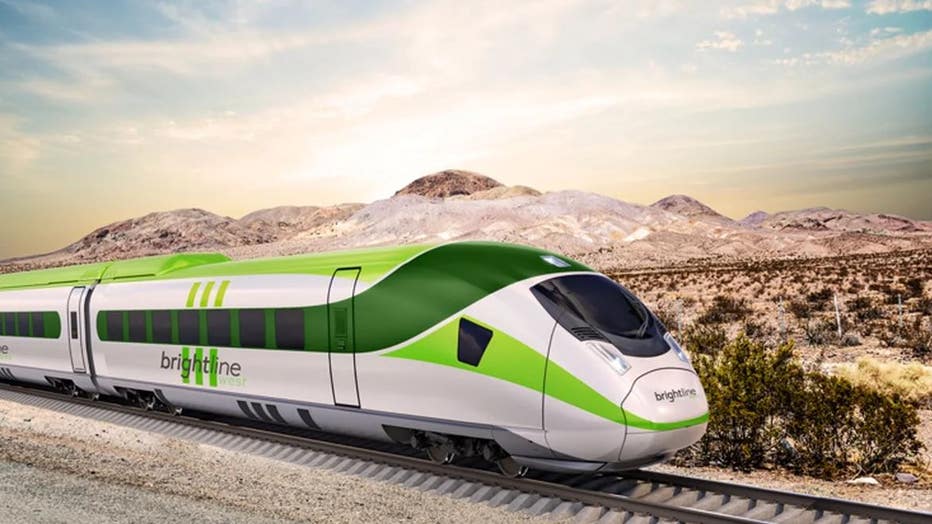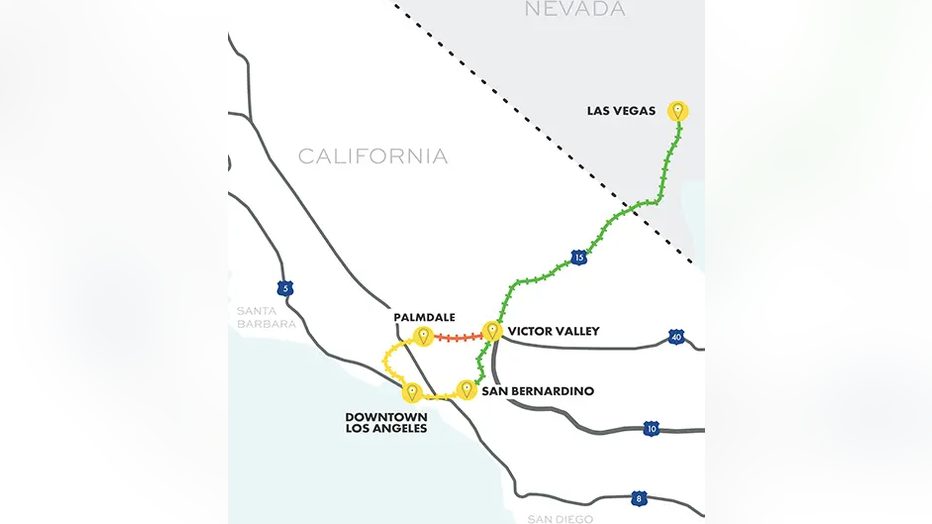California to Las Vegas bullet train advances key step
Bullet train from LA to Las Vegas one step closer to reality
Construction on a highly anticipated bullet train from LA to Las Vegas is slated to begin later this year
LOS ANGELES - A high-speed train connecting Los Angeles to Las Vegas passed another major hurdle recently, advancing the highly-anticipated project a step forward toward construction.
The Federal Rail Authority last week finalized its environmental review for part of Brightline's project and concluded "no significant impacts" for the planned 49-mile line that would be located between Rancho Cucamonga and Victorville. The tracks would run within the right of way of the 15 Freeway.
SUGGESTED: California to Las Vegas bullet train passes another major hurdle
The FRA evaluated the proposal, determined what impacts it could have on the local environment, traffic, and "natural aesthetic" and ultimately determined that Brightline’s proposed solutions met all concerns. The permitting process has also been completed.

Photo courtesy Brightline West
Last month, Brightline was granted $25 million in funding to go toward building passenger rail stations in Southern California.
With the environmental approval in place, officials said Brightline remains on track to break ground at the end of this year, with hopes of starting service by early 2027.
In March, Brightline announced the memorandum with the High Speed Rail Labor Coalition, which includes 13 rail unions representing more than 160,000 freight, regional, commuter and passenger railroad workers.
SUGGESTED: Construction to begin on bullet train connecting SoCal to Las Vegas
According to Brightline, the expected travel time between Las Vegas and Los Angeles is approximately 2.5 hours. The zero-emission electric trains could carry 500 passengers at speeds of nearly 200 mph
Approximately 50 million one-way trips are made annually between these two destinations with 85% of them by car or bus, the company said. At full operations, Brightline expects to attract approximately 12 million one-way trips each year.
Amenities for travelers include free onboard WiFi, ADA accessibility from station to train, a wide selection of food and drinks, checked luggage, and hotel check-in services.
Los Angeles-Las Vegas high-speed rail: Lawmakers request fast-tracked funds.
A bipartisan Congressional group is asking the Biden administration to fast-track funding for a high-speed rail line between Los Angeles and Las Vegas.
Union labor will be used during construction, the company and the Southern Nevada Building Trades Union have announced in recent weeks.
SUGGESTED: Point of View: California's bullet train
Construction was originally set to begin in 2020, but was halted when the company postponed a planned $2.4 billion bond sale to finance initial tracks and stations for the $8 billion project. The company blamed the delay on market instability because of the ongoing COVID-19 pandemic.
The project could be "the blueprint for how we can connect major city pairs that are too short to fly and too far to drive," said Mike Reininger, CEO of Florida-based Brightline Holdings LLC, the only privately owned and operated intercity passenger railroad in the United States.
Amtrak passenger service to Las Vegas ended in 1997 with the demise of a train called the Desert Wind. The concept of building a bullet train through the Mojave Desert dates back to at least 2005 under various names. It has seen starts and stops over the years and became sidetracked during the COVID-19 pandemic.

Other places where high-speed trains have been proposed include the 500-mile system linking Los Angeles and San Francisco.
The Rancho Cucamonga station will connect to Metrolink’s regional rail network, which includes stations in Los Angeles, Riverside, Orange, San Diego, and Ventura counties.
The Associated Press contributed to this report.

